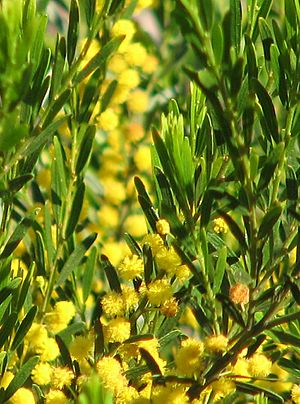Acacia lineata facts for kids
Acacia lineata, also called streaked wattle or narrow lined-leaved wattle, is a plant found in eastern Australia. It belongs to the Acacia group, which is the biggest group of flowering plants in Australia. There are about 1000 different Acacia species. They grow in many places, from the coast to the desert.
The name Acacia comes from a Greek word meaning "to sharpen." The name lineata comes from a Latin word meaning "marked by fine parallel lines."
Today, Acacia lineata is not considered rare or in danger. It grows in Queensland, New South Wales, South Australia, and Victoria. In these areas, it is sometimes seen as uncommon.
Quick facts for kids Acacia lineata |
|
|---|---|
 |
|
| Scientific classification | |
| Genus: |
Acacia
|
| Species: |
lineata
|
 |
|
| Occurrence data from AVH | |
Contents
What Does Streaked Wattle Look Like?
Acacia lineata is a bushy shrub. It usually grows between 0.5 and 2 meters (1.6 to 6.5 feet) tall. It can spread out 1 to 2.5 meters (3 to 8 feet) wide. Its small branches are round, hairy, and a bit sticky. This plant lives for many years.
Special Leaves Called Phyllodes
Many Acacia plants, including Acacia lineata, have special "leaves." These are not true leaves. They are actually changed leaf stems called phyllodes.
The phyllodes of Acacia lineata are dark green. They can be a little hairy or very hairy. Often, they feel sticky. They grow in small groups and stand up straight. Each phyllode ends in a small point. They are 0.7 to 2.5 cm (0.3 to 1 inch) long. They are also 1 to 3 mm (0.04 to 0.12 inches) wide. Their edges are thick. You can see a vein running along the middle. There is also a small gland near the bottom.
Bright Yellow Flowers and Seed Pods
The flowers of Acacia lineata are bright yellow. They grow in round balls, about 4 to 6 mm (0.16 to 0.24 inches) across. Each ball has 10 to 16 tiny flowers. These flower balls grow on thin stalks. The stalks are 2.5 to 10 mm (0.1 to 0.4 inches) long. They grow by themselves or in pairs from where the phyllodes join the stem.
After flowering, the plant makes seed pods. These pods are also called legumes. They are curved and can be flat or twisted. They are 2 to 6 cm (0.8 to 2.4 inches) long. They are also 2 to 4 mm (0.08 to 0.16 inches) wide. When they are ripe, they turn from green to dark brown. They feel like paper. The pods are slightly hairy and sticky.
Seeds of the Streaked Wattle
The seeds inside the pods are greyish-black. They are 3 to 5 mm (0.12 to 0.2 inches) long. Each seed is shaped like an oblong. They are spaced out along the pod. Flat parts separate each seed from the next. Each seed has a short, folded tip. This tip widens into a pale, fleshy part called an aril.
Where Does Streaked Wattle Grow?
Acacia lineata is found in different places. It grows in central to western New South Wales. You can find it around the Killara Road area near Narrandera. It also grows in the mallee areas northeast of Barellan.
This wattle is also found in southeast Queensland. It grows in the northwest Mallee areas of Victoria. You can also see it in southeast South Australia. Known spots include the Yorke Peninsula and Murray regions.
Acacia lineata grows in many types of places. These include sclerophyll forests and woodlands. But it is most often found in mallee communities.
How Streaked Wattle Survives
Acacia lineata can grow in different types of soil. It likes alkaline, sandy, or gravelly soils.
Surviving in Dry Places
The phyllodes help Acacia lineata live in dry, semi-desert areas. They help the plant lose less water. The phyllodes are small and point upwards. They are also a bit hairy. These features help the plant save water.
Helping the Soil
Acacias are special because they can "fix" nitrogen in the soil. This means they turn nitrogen from the air into a form plants can use. They do this with tiny helpers called rhizobia. These are bacteria that live on the plant's roots. This process helps other plants grow better too.
How Streaked Wattle Spreads
Acacia lineata flowers appear from July to October. The exact time depends on the region. Its seeds become ripe during the summer.
The pale aril on the seeds suggests something interesting. It means that ants likely help spread the seeds around.
How People Use Streaked Wattle
Acacia lineata is planted as a pretty shrub. You can see it in parks and along roadsides. It grows best in places with mild weather. It can handle some dry weather and frost. You can grow it from a seed or a cutting.
Acacias are good for wildlife. They provide lots of pollen for insects. They offer safe nesting places for birds. Birds also eat their seeds.
Indigenous Australians have used many types of Acacia plants for a long time. They use the seeds and roots as food. The wood is used for fires, tools, and shelters. Acacias also provide homes for other animals like birds and kangaroos, which are also food sources. They can also be used as a sign to know what season it is.
Images for kids



